What are stretch marks?
Stretch marks (also known as striae gravidarum) are narrow and long stripes or lines that appear on the skin. It is also considered a type of scar that disfigures the natural look of the skin. Stretch marks form in the second layer of skin out of three layers. They are developed due to the quick stretching and expansion of the skin (due to sudden weight gain or pregnancy) and the failure to go back to normal because of exceeding elasticity limits. In other words, the stretch causes the second layer to tear, and the third layer, beneath the torn tissue, to become visible.
What are stretch marks?
Stretch marks do not cause any pain. They appear as purple, black, red, or even blue stripes and usually fade into white, silvery, or glossy lines over time and become less noticeable. But some people don’t like how their skin looks with these stretch marks on them, especially when they are severe, cover a considerable portion of the body, and affect self-image. Stretch marks develop on different parts of body, including:
- abdomen
- breasts
- upper arms
- buttocks
- lower back and flanks
- hips
- thighs
Who gets stretch marks?
People who experience extreme skin growth are more likely to develop stretch marks, such as pregnant women, people who suffer from obesity, or sportspeople who do excessive exercises, like bodybuilders and weight lifters. It is also a part of puberty as the body goes through many changes. So, many people experience it, and while some people are prone to getting them more than others, some people don’t experience them at all.
Who are more likely to develop stretch marks
What causes stretch marks?
- Rapid changes in weight – Stretch marks might appear in both cases of weight gain or weight loss.
- Pregnancy – 50% to 90% of pregnant women experience them, and usually, they fade and become less noticeable between 6 to 12 months after giving birth.
- Puberty – As the body goes through lots of changes and experiences rapid growth, developing stretch marks are common at this stage.
- Special exercises– Such as weight training when the rapid growth of muscles occurs.
- Steroid-containing creams, lotions, and ointments – Applying these kinds of skin products (such as hydrocortisone) for more than a few weeks may cause the development of stretch marks.
- Corticosteroids medicines – In case of prolonged consumption, they cause the accumulation of water and electrolytes in the body, leading to a puffy and pseudo-obese appearance and reducing the collagen level of the skin which eventually causes stretch marks.
- Specific types of surgeries – Breast enlargement surgery, weight loss surgery, or other kinds of procedures that change the size of the body may lead to getting stretch marks afterward.
- Certain medical disorders – Some medical conditions such as Cushing syndrome or Marfan syndrome may cause stretch marks. In Marfan syndrome, a reduction of the skin’s elasticity happens, and Cushing’s syndrome may make the body produce a certain hormone at a higher level that causes rapid weight gain.
- High level of Cortisol hormone – The fluctuation of Cortisol, the stress hormone in the body, might affect the elastic fibers of the skin as cortisol could convert to cortisone and affect the elasticity.
- Genetics – If there is a history of stretch marks in a person, there is a higher risk for the rest of the family members to develop them.
- Gender – women are more likely to develop these marks.
What causes stretch marks?
What is the best treatment for stretch marks?
Like any other scar, stretch marks may never disappear completely, but they often fade over time (maybe years) and become less noticeable without any treatment. They affect how our skin looks, disfigure its natural appearance, damage our self-image, and causes cosmetic concerns which even may lead to anxiety. So, some people want to get rid of stretch marks, hide them or make them least noticeable.
Treating stretch marks with products found at a store or online might be expensive yet ineffective. So, if you are looking for a way to get rid of stretch marks and do not want to waste your time and money, consulting a specialist, plastic surgeon, or dermatologist can be helpful. According to the scars’ situation and the creation time, they offer one or a combination of treatments that suits your conditions best.
Generally, in-office procedures have shown better results compared to others methods, and surgery is the only way to get rid of them permanently. But there are other temporary ways to cover them, as well.
13 ways to get rid of stretch marks
Here are 13 ways to treat stretch marks, or at least make them less visible (permanently and temporarily):
1. Creams, lotions, and gels containing Retinoid and Hyaluronic Acid
Researches have shown that Retinoid (vitamin A) might help to make early stretch marks less noticeable. Products such as tretinoin (retinoic acid or synthetic vitamin A) help the skin rebuild collagen protein and improve the look of scars only a few months old. In some researches, Hyaluronic Acid is introduced as an effective substance, as well.
2. Aloe Vera
Although little clinical evidence for the efficiency of Aloe vera for stretch marks exists, it boosts the production of skin collagen and might help the process of healing, especially in early scars.
3. Microneedling (collagen induction therapy)
Microneedling is a minimally-invasive cosmetic procedure, which uses a hand-held device with multiple micro-sized needles to prick the skin to promote the growth of elastin and collagen, enhance the look of the skin, and reduce the visibility of the scars.
4. Chemical peel
As a skin rejuvenation technique, chemical peel removes the old dead layer of the skin and reveals the underneath layer by using chemicals such as TCA or Glycolic acid to stimulate the growth of a new layer.
5. Microdermabrasion
Also helping with the production of elastin and collagen, this method is useful for removing wrinkles and sun damages as well as stretch marks. By exfoliation and removing the top dead layer (with a special applicator), microdermabrasion rejuvenates the skin by building new cells.
6. Laser Treatment
Laser therapy uses 2 different types of lasers with different approaches of treatment:
- Ablative lasers (like: Erbium YAG for surface scars and CO2 for deep scars) remove the upper layer of skin and encourage new growth which leads to the generation of smooth skin tissues with improved look and texture along with collagen production, making the scars less apparent.
- Non-ablative lasers (like: Fraxel for white and old marks, ICON 1540 Fractional Laser, the only FDA-approved laser for treating stretch marks, Alexandrite, CoolTouch, and N-lite) instead of destroying the outer skin layer, target the inner layers to stimulate collagen growth and reconstruction from inside out.
Stretch marks develop on different parts of body such as abdomen, breasts, upper arms, buttocks, lower back and flanks, hips and thighs.
7. RF skin resurfacing
This radiofrequency skin treatment helps to generate collagen in the lower skin layers and make a smoother appearance by creating micro-injuries to the skin.
8. PRP
As another way for collagen generation, PRP (Platelet-rich plasma) uses the patient’s processed blood and its isolated platelets to stimulate the healing process of the body, done by applying it topically on the skin or injection. For better results, it could be combined with other methods, such as Microneedling, Ultrasound therapy, or lasers.
9. Ultrasound Therapy
It is an innovative approach that rejuvenates the skin by vibrating the cells, improving circulation, and producing oxygen bubbles using a hand-held machine that radiates high-frequency waves.
10. Sunless self-tanners
Some people find sunless self-tanners useful in covering up the stretch marks. But it is not a permanent solution.
11. Body makeup
As the most temporary stretch mark solution, using body makeup with a matching tone to your skin could help to cover the marks.
12. Cosmetic surgery
A surgical procedure is the only effective solution to get rid of stretch marks completely. Although it has effective results, when the stretch marks are spread all over a part of the body (such as the abdomen), one surgery can only help to remove a considerable portion of it, not all. It is because in surgeries like tummy tuck, the surgeon removes the lower part of the abdomen skin (below the belly button), and uses the upper skin to cover the whole area. In this case, if there are stretch marks on the upper skin as well as the lower section, they won’t go away completely. So, patients must be realistic about the results. However, a combination of surgeries has better results.
13. Mommy makeover surgery
Mommy makeover is a special kind of surgery for women who have given birth and want to improve the appearance of their bodies after pregnancy. It is a combination of customized procedures and contouring surgeries like tummy tuck and breast, butt, and thigh lift for each patient, which, apart from tightening the skin and bringing back to body to pre-pregnancy condition, can also reduce or totally remove the stretch marks and other imperfections.
If you are looking for a permanent or efficient way, discussing it with our specialists might help you to choose the best option.
Stretch mark treatment Before and After photo
What Are Stretch Marks?
Stretch marks are visible lines on the skin that often appear during pregnancy, puberty, or after sudden weight gain. Many people ask, “what is the cause of stretch marks?” The main reasons are rapid stretching of the skin, hormonal changes, and sometimes genetics.
Do Stretch Marks Go Away on Their Own?
One of the most common questions is, “can stretch marks go away without treatment?” The truth is, stretch marks usually fade with time, but they rarely disappear completely. That’s why many people search for methods on “how to fade stretch marks” or treatments for long-term improvement.
Stretch Marks Treatment Options
There are several ways to improve the appearance of stretch marks. If you are looking for the “best way to get rid of stretch marks”, dermatologists often recommend a combination of skincare products, laser therapy, or microneedling. These methods are among the most effective forms of stretch marks removal.
How to Remove Stretch Marks Fast?
For people who want quick results, the question “how to remove stretch marks fast” is very common. While there is no miracle overnight solution, treatments like fractional lasers and topical retinoids can speed up the fading process.
Home remedies for stretch marks that do not work
There are some advised or advertised treatments and home remedies for treating stretch marks that will not help you get rid of the stretch marks.
Some people say that topical treatment such as creams and ointment made out of vitamin E, cocoa butter, olive oil, almond oil, glycolic acid on the skin, helps to treat or even prevent the appearance of stretch marks. Although they are all good for the skin, there is no scientific evidence that they have any positive effect on stretch marks or can prevent them.
Although sunless self-tanners might help cover the scars in some cases, regular tanning and tanning beds don’t have the same effect, as the stretch marks do not get tan easily, and they might look more obvious after tanning.



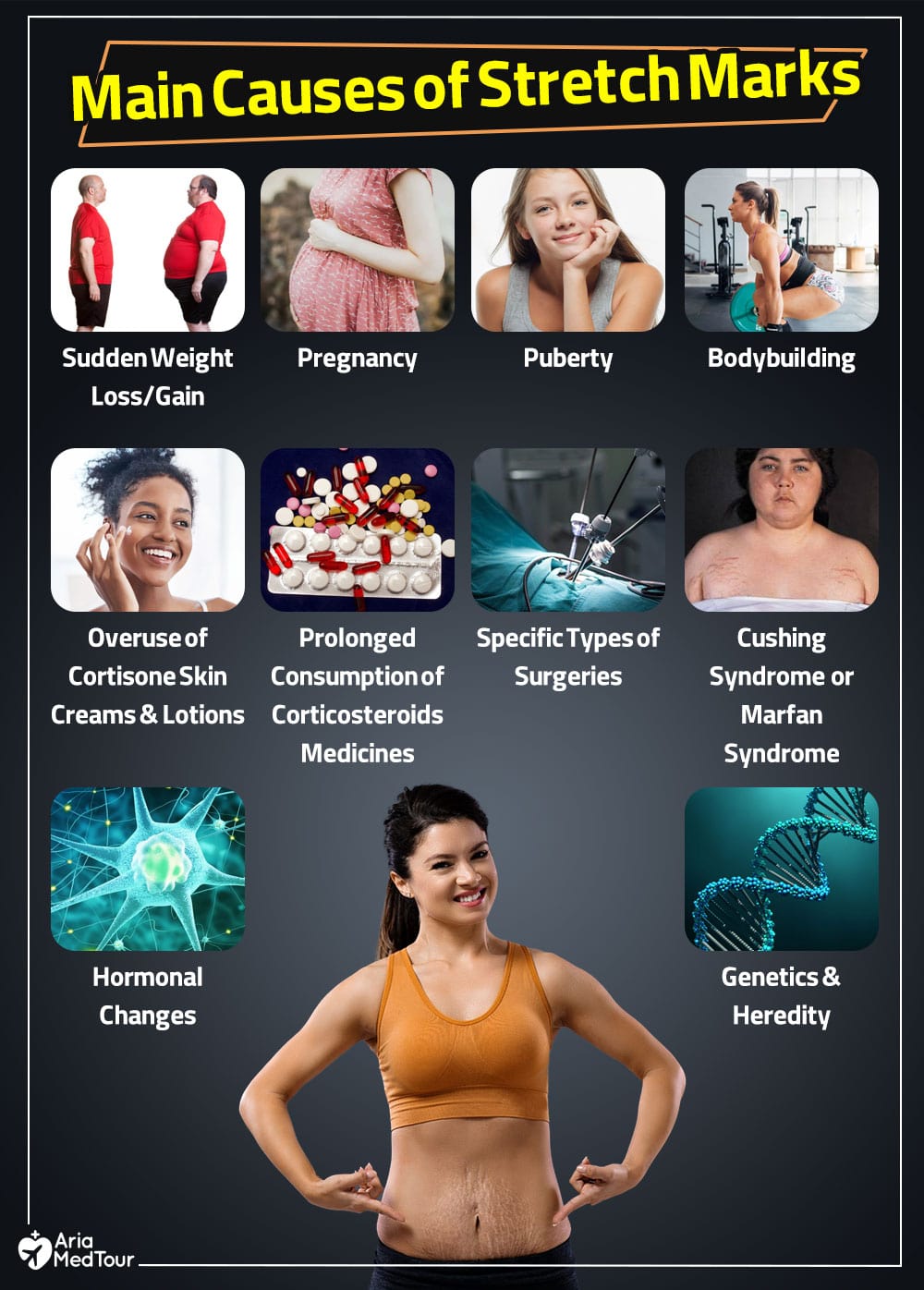
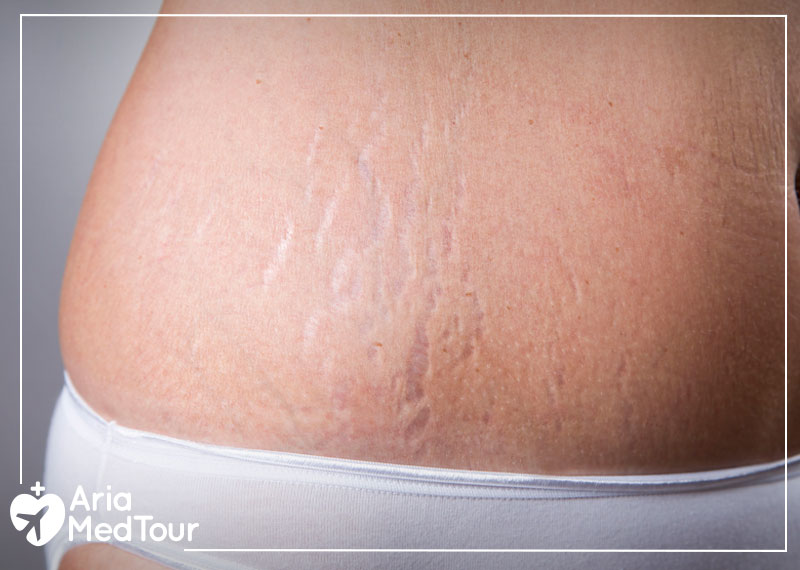


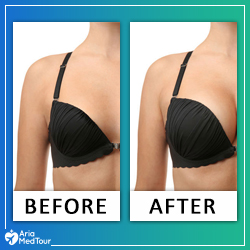
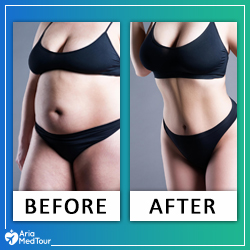
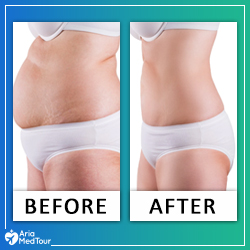
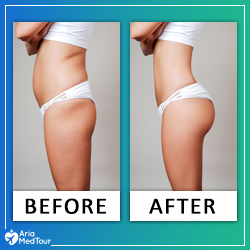
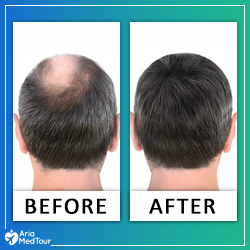
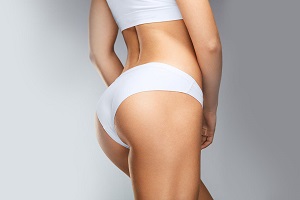



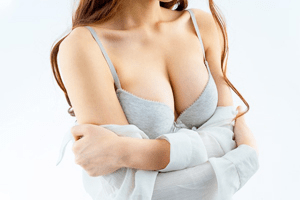


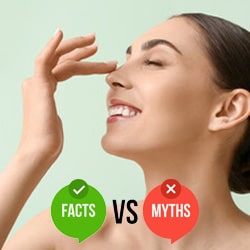
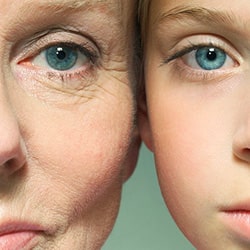

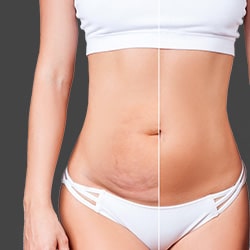
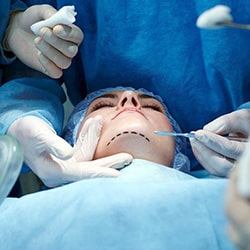


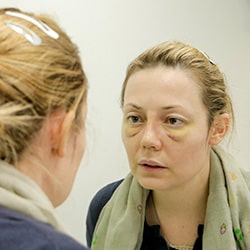
Hi, I just want to know what are stretch marks? I’ve got some lines on my skin and I’m not sure if they are really stretch marks. Also, what causes stretch marks in the first place?
stretches or shrinks quickly. The main causes of stretch marks are rapid weight changes, pregnancy, puberty growth spurts, and sometimes genetics. In our article we’ve explained in detail what is the cause of stretch marks and why they appear in certain body areas like thighs, abdomen, or arms.
I just had a baby and now I’m worried about these lines on my belly. Is there any safe method on how to get rid of stretch marks after pregnancy? And really, do stretch marks go away with time or do I need a treatment?
Hi Sarah, congratulations on your baby! Many new moms experience this. While stretch marks may fade over time, they rarely disappear completely on their own. The best treatment for stretch marks depends on your skin type and the depth of the marks. Options like creams, laser therapy, and microneedling can help fade stretch marks gradually. In our FAQ we’ve also answered the question: can stretch marks go away naturally or not.
I started bodybuilding and suddenly noticed stretch marks on thighs and shoulders. Can someone explain what cause stretch marks when working out? And also, how to reduce stretch marks fast before they get worse?
Hi David, that’s very common among athletes. The cause of stretch marks during workouts is usually rapid muscle growth that stretches the skin. To reduce stretch marks, hydration, topical creams, and maintaining gradual growth can help. For faster results, we discuss in the article how to remove stretch marks fast and which clinical methods work better for athletes.
As a dermatologist, I often get patients asking how to remove stretch marks permanently or how do you get rid of stretch marks in a safe way. In your opinion, what’s the best way to get rid of stretch marks and which stretch marks treatment do you usually recommend?
Thank you Dr. Roberts for your professional insight. As you know, complete stretch marks removal is challenging, but several options can significantly improve them. Laser therapy and microneedling are often considered the best treatment for stretch marks, while topical retinoids and hyaluronic acid help in milder cases. We’ve explained in the article that while you can get rid of stretch marks to a large extent, results depend on skin condition and consistency of treatment.